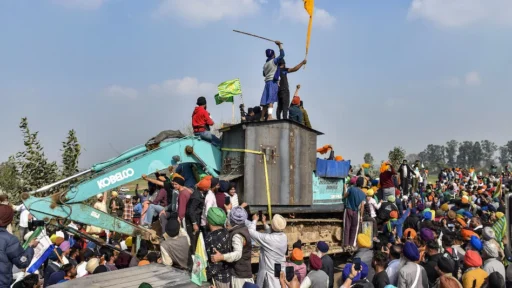
Tens of Thousands of Farmers Return to Delhi Borders
On February 13, 2024, tens of thousands of farmers from Punjab, Haryana, and western Uttar Pradesh launched a renewed protest along Delhi’s Shambhu and Tikri borders. The farmers demanded legal guarantees for Minimum Support Price (MSP), fixed daily wages under MGNREGA, pension schemes for older farmers, and justice for victims of police action during earlier protests.
This movement, widely referred to as the 2024 Indian farmers’ protest, quickly became a defining moment in India’s agrarian politics—bridging economic demands and democratic expression in equal measure.
A Return to the Roads
Just months after earlier rallies in 2021 and 2022, farmers returned, this time with focused demands:
-
A legal guarantee of MSP for all crops
-
A pension of ₹10,000 per month for farmers above 60
-
Daily wage of ₹700, 200 days assured employment via MGNREGA
-
Compensation and withdrawal of cases related to the Lakhimpur Kheri violence
Their methodical, largely peaceful protest included tractor marches, road blockades, and night-long sit-ins. While some clashes occurred at entry points, the mood remained resolute and disciplined.
Political and Economic Stakes
The timing was strategic. With general and state elections looming, farmers seized national attention as stakeholders whose policy demands could sway voting blocs. The protest aligned with national concerns over agricultural distress, rising input costs, stagnant incomes, and climate uncertainty.
Multiple opposition parties supported the demand for MSP and farmer welfare measures, positioning the protest as a valid electoral issue.
Public Sentiment and Protest Dynamics
Across news channels and social media, farmers received widespread sympathy. Commentary emphasized the intersection of agrarian risk and democratic bargaining. Many urban observers drew parallels with global movements for economic justice and food security.
Organizers alternated planned road closures with negotiations. Farmers showcased their unity with banners, chants, and solidarity statements—many emphasizing peaceful resistance and hope rather than confrontation.
Government Response and Negotiations
Initial government reaction was cautious; law enforcement secured protest border points and touted continued dialogue. The Union Agriculture Ministry formed committees to explore MSP implementation and rural pension schemes.
While some local tensions flared—particularly at Shambhu and Tikri borders—authorities largely refrained from large-scale force, aware that escalation could trigger national backlash.
Impact on National Conversation
The protest reframed agriculture from a background concern into a front-page issue. Key takeaways:
-
Long-deferred demands like MSP rights and farm pensions moved into policy discourse
-
Parliamentary leaders and media analysts debated agrarian economics more vigorously
-
Delhi urban centers grappled with logistical disruption, but also with questions of equity, wage justice, and political priorities
Why This Protest Matters
-
Active Democracy in Action: Citizens are demanding entitlement reforms through peaceful mobilization
-
Economic Pressure Points: Farmers highlight gaps in rural incomes despite high GDP growth
-
Elections and Accountability: Protest reflects political leverage ahead of poll season
-
Policy Impact: Agendas like MSP legislation and farmer pension schemes gained traction in policy circles
Broader Themes and Future Implications
This moment connected with two long-term themes in India:
-
Agrarian distress: Year-after-year, farmers suffer due to volatility, debts, and limited institutional support
-
Policy reform potential: Protests may catalyse legislative shifts toward formal support systems for farmers and labourers
Going forward, success depends on government follow-through—similar protests in 2025 or beyond may demand continued pressure if promises go unmet.
Reporting Insight: What Comes Next
-
Will the government legislate MSP guarantees and pension schemes?
-
Can protests be sustained through rural winter, or will political timing distort demands?
-
How will urban migration and climate shocks interplay with agrarian policy?
This protest may mark the start of the most politically consequential rural movement since the early